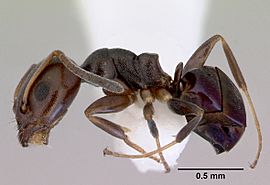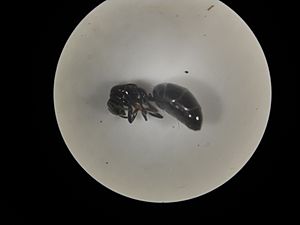Ochetellus facts for kids
Quick facts for kids Ochetellus |
|
|---|---|
 |
|
| Ochetellus glaber worker | |
| Scientific classification | |
| Kingdom: | |
| Phylum: | |
| Class: | |
| Order: | |
| Family: | |
| Subfamily: |
Dolichoderinae
|
| Tribe: |
Leptomyrmecini
|
| Genus: |
Ochetellus
Shattuck, 1992
|
| Type species | |
| Hypoclinea glabra Mayr, 1862
|
|
| Diversity | |
| 7 species, 3 subspecies | |
Ochetellus is a group of small, black ants. They were first described in 1992 by a scientist named Steve Shattuck. These ants are part of the Dolichoderinae subfamily, which belongs to the larger Formicidae family.
Ochetellus ants come in different sizes. Worker ants are usually about 1.75 to 3 millimeters long. The males are smaller, around 1.6 millimeters. Queens are the biggest, reaching up to 4 millimeters in length. Most of these ants live in Australia in many different places. Some species are also found in Asia. One species, Ochetellus glaber, has even spread to New Zealand and the United States.
You can find their homes in rotten wood, in the ground, or under rocks. They also live in cities, sometimes even inside houses. These ants are active both during the day and at night. They look for food on trees, in plants, and in homes. They eat many different things like fruits, insects, sweet liquids, and even bird droppings. They also visit flowers and care for certain butterfly larvae. A lizard called the Thorny devil loves to eat Ochetellus ants. Other ant species also hunt them.
Contents
Meet the Ochetellus Ants
What are Ochetellus Ants?
Ochetellus is a genus of ants. This means it's a group of closely related ant species. Steve Shattuck first named this group in 1992. He put them into the Dolichoderinae ant subfamily. The main species that represents this group is Ochetellus glaber. It was first described in 1862 by Gustav Mayr.
There are seven known species and three subspecies in the Ochetellus genus. These ants were once thought to be part of the Iridomyrmex group. But scientists found enough differences to give them their own genus.
How to Identify Ochetellus Ants
Ochetellus ants are generally small and black. Their size can vary a bit between species. Worker ants are typically 1.75 to 3 millimeters long. Male ants are smaller, about 1.6 millimeters. The queens are the largest, with some like Ochetellus sororis queens reaching 4 millimeters.
Even though they look similar to Iridomyrmex ants, Ochetellus ants have unique features. Their compound eyes are placed differently on their heads. Also, the shape of their clypeal margin (a part of their face) and their mesosoma (middle body section) are different. They also look a bit like Dolichoderus ants but are smaller. Their petiole (a narrow waist part) is thin and spreads out on the sides. Their heads are also thinner than most ants in the Dolichoderinae group.
On their heads, the back edge can curve in or out. They do not have ocelli, which are simple eyes. Their antennae have twelve segments. Their mandibles (jaws) have six to eight teeth, plus a larger tooth at the tip.
Where Ochetellus Ants Live
Distribution and Habitats
Ochetellus ants are originally from Australia. They have also been brought to New Zealand. In Asia, you can find them in India, Japan, the Philippines, and southern Burma. They also live on islands like Fiji, Mauritius, and New Caledonia.
One species, Ochetellus glaber, arrived in Hawaii in 1977 and is now considered an invasive species. It has spread across many Hawaiian islands. This ant has also been found in Florida in the United States.
These ants can live in many different climates. They are often found in dry and moderately wet places. While they are known as a tropical group, the first Ochetellus ant found was from cooler Sydney. They live in woodlands, forests, and even on beaches and in cities.
Nesting Habits
Ochetellus ants often build their nests in trees, logs, or rotten wood. They also nest in sand, soil, under rocks, and in tree stumps or branches. In cities, they might build nests under cracked paths, inside house walls, or in patio areas.
Some Ochetellus species are considered pests because they go into pastures and houses. They especially like liquids and sweet foods. Ochetellus flavipes ants build unique small runways across the ground for their nests. These nests are similar to those built by some Polyrhachis ants, which make platforms from plants to house insects they care for.
Life and Behavior of Ochetellus Ants
Foraging and Diet
Ochetellus workers form lines to search for food. They look for food inside buildings, on eucalyptus trees, on the ground, or on low plants. They are active both during the day and at night. However, they are not active all the time. They are less active on sunny days but become very busy right after it rains.
Ochetellus ants are omnivores, meaning they eat both plants and animals. They mainly eat arthropods (like insects). When they enter human homes, they prefer liquids and sweets. Workers will eat eggs of certain butterflies, fruit fly pupae, and larvae. They also attack wasp nests. Their diet also includes honeydew (a sweet liquid from insects), nectar, bird droppings, dead animals, fruits, plants, seeds, sugar, fats, and grease. O. glaber is known to take nectar from plants without helping the plant in return.
Plant Interactions
Foraging workers often visit Pisonia flowers to drink their nectar. They also visit other flowers like Canavalia, Commicarpus, Ipomoea, Melanthera, Plumbago, and Scaevola. Ochetellus flavipes ants regularly care for mealybugs called Prorsococcus acanthodus. They even build shelters to protect them. They also look after the larvae (young) of several butterfly species, including the Pale Ciliate Blue and different types of Azure butterflies.
Predators
Other ants and the Thorny devil lizard (Moloch horridus) often hunt Ochetellus workers. A thorny devil can eat about 24 to 45 ants per minute! In one day, a thorny devil might eat as many as 2,500 ants.
Reproduction and Colony Growth
During the nuptial flight (a special mating flight), a queen ant might mate with several male ants. However, each male ant usually mates with only one queen. Interestingly, Ochetellus glaber queens only mate with one male.
Sometimes, new Ochetellus colonies start by "budding." This is when a part of the main colony, including queens, workers, and young ants (eggs, larvae, and pupae), leaves to start a new nest in a different place.
See also
 In Spanish: Ochetellus para niños
In Spanish: Ochetellus para niños



